An Identity Authentication Method Combining Liveness Detection and Face Recognition
Abstract
1. Introduction
2. Related Works
3. Methodology
3.1. Problem Statements
3.2. Model Framework
3.3. Liveness Detection Based on IR Image Features (LDIR)
3.4. Improved FaceNet Model for Application-IFaceNet
3.4.1. FaceNet Model
3.4.2. IFaceNet
Set a Valid Threshold
Building a Unknown Category
4. Experimental Results and Analysis
4.1. Experiment Settings
4.2. Datasets
4.3. Integrated Experiments
4.4. Performance Evaluation
5. Conclusions and Future Work
Author Contributions
Funding
Acknowledgments
Conflicts of Interest
References
- Chihaoui, M.; Elkefi, A.; Bellil, W.; Ben Amar, C. A survey of 2D face recognition techniques. Computers 2016, 5, 21. [Google Scholar] [CrossRef]
- Schroff, F.; Kalenichenko, D.; Philbin, J. FaceNet: A unified embedding for face recognition and clustering. In Proceedings of the IEEE Conference on Computer Vision and Pattern Recognition (CVPR), Boston, MA, USA, 7–12 June 2015; pp. 815–823. [Google Scholar]
- Li, Y.; Xu, K.; Yan, Q.; Li, Y.; Deng, R.H. Understanding OSN-based facial disclosure against face authentication systems. In Proceedings of the 9th ACM Symposium on Information, Computer and Communications Security, Kyoto, Japan, 3–6 June 2014; ACM: New York, NY, USA; pp. 413–424. [Google Scholar]
- de Freitas Pereira, T.; Komulainen, J.; Anjos, A.; De Martino, J.M.; Hadid, A.; Pietik¨ainen, M.; Marcel, S. Face liveness detection using dynamic texture. EURASIP J. Image Video Process. 2014, 2, 4. [Google Scholar] [CrossRef]
- Boulkenafet, Z.; Komulainen, J.; Hadid, A. Face spoofing detection using colour texture analysis. IEEE Trans. Inf. Forensics Secur. 2016, 11, 1818–1830. [Google Scholar] [CrossRef]
- Chingovska, I.; Anjos, A.; Marcel, S. On the effectiveness of local binary patterns in face anti-spoofing. In Proceedings of the 11th International Conference of the Biometrics Special Interes Group, Darmstadt, Germany, 6–7 September 2012; IEEE: Piscataway, NJ, USA, 2012; pp. 1–7. [Google Scholar]
- Raghavendra, R.; Raja, K.B.; Busch, C. Presentation attack detection for face recognition using light field camera. IEEE Trans. Image Process. 2015, 24, 1060–1075. [Google Scholar] [CrossRef] [PubMed]
- Li, X.B.; Komulainen, J.; Zhao, G.Y.; Yuen, P.C.; Pietik¨ainen, M. Generalized face anti-spoofing by detecting pulse from face videos. In Proceedings of the 23rd International Conference on Pattern Recognition, Cancun, Mexico, 4–8 December 2016; IEEE: Piscataway, NJ, USA, 2016; pp. 4244–4249. [Google Scholar]
- Hernandez-Ortega, J.; Fierrez, J.; Morales, A.; Tome, P. Time analysis of pulse-based face anti-spoofing in visible and NIR. In Proceedings of the Conference on Computer Vision and Pattern Recognition Workshops, Salt Lake City, UT, USA, 18–22 June 2018; IEEE: Piscataway, NJ, USA, 2018; pp. 544–552. [Google Scholar]
- Wang, S.Y.; Yang, S.H.; Chen Y, P.; Huang, J.W. Face liveness detection based on skin blood flow analysis. Symmetry 2017, 9, 305. [Google Scholar] [CrossRef]
- Sun, L.; Pan, G.; Wu, Z.H.; Lao, S.H. Blinking-based live face detection using conditional random fields. In Proceedings of the International Conference on Biometrics, Seoul, Korea, 27–29 August 2007; Springer: Berlin/Heidelberg, Germany, 2007; pp. 252–260. [Google Scholar]
- Li, J.W. Eye blink detection based on multiple gabor response waves. In Proceedings of the International Conference on Machine Learning and Cybernetics, San Diego, CA, USA, 11–13 December 2008; IEEE: Piscataway, NJ, USA, 2008; pp. 2852–2856. [Google Scholar]
- Kollreider, K.; Fronthaler, H.; Faraj, M.I.; Bigun, J. Real-time face detection and motion analysis with application in “liveness” assessment. Trans. Inf. Forensics Secur. 2007, 2, 548–558. [Google Scholar] [CrossRef]
- Bharadwaj, S.; Dhamecha, T.I.; Vatsa, M.; Singh, R. Computationally efficient face spoofing detection with motion magnification. In Proceedings of the IEEE Conference on Computer Vision and Pattern Recognition Workshops, Portland, OR, USA, 23–28 June 2013; pp. 105–110. [Google Scholar]
- Yang, J.W.; Lei, Z.; Li, S.Z. Learn convolutional neural network for face anti-spoofing. arXiv 2014, arXiv:1408.5601. [Google Scholar]
- Atoum, Y.; Liu, Y.J.; Jourabloo, A.; Liu, X.M. Face antispoofing using patch and depth-based cnns. In Proceedings of the IEEE International Joint Conference on Biometrics, Denver, CO, USA, 1 October 2017; IEEE: Piscataway, NJ, USA, 2017; pp. 319–328. [Google Scholar]
- Li, L.; Feng, X.Y.; Boulkenafet, Z.; Xia, Z.Q.; Li, M.M.; Hadid, A. An original face anti-spoofing approach using partial convolutional neural network. In Proceedings of the 6th International Conference on Image Processing Theory Tools and Applications, Oulu, Finland, 12–15 December 2016; IEEE: Piscataway, NJ, USA, 2016; pp. 1–6. [Google Scholar]
- Tu, X.K.; Fang, Y.C. Ultra-deep neural network for face anti-spoofing. In Proceedings of the International Conference on Neural Information Processing, Guangzhou, China, 14–18 November 2017; Springer: Berlin/Heidelberg, Germany, 2017; pp. 686–695. [Google Scholar]
- Li, L.; Feng, X.Y.; Jiang, X.Y.; Xia, Z.Q.; Hadid, A. Face antispoofing via deep local binary patterns. In Proceedings of the IEEE International Conference on Image Processing, Beijing, China, 17–20 September 2017; IEEE: Piscataway, NJ, USA, 2017; pp. 101–105. [Google Scholar]
- Nagpal, C.; Dubey, S.R. A performance evaluation of convolutional neural networks for face anti spoofing. arXiv 2018, arXiv:1805.04176. [Google Scholar]
- Li, H.L.; He, P.S.; Wang, S.Q.; Rocha, A.; Jiang, X.H.; Kot, A.C. Learning generalized deep feature representation for face anti-spoofing. IEEE Trans. Inf. Forensics Secur. 2018, 13, 2639–2652. [Google Scholar] [CrossRef]
- Gan, J.Y.; Li, S.L.; Zhai, Y.K.; Liu, C.Y. 3D convolutional neural network based on face anti-spoofing. In Proceedings of the International Conference on Multimedia and Image Processing, Wuhan, China, 17–19 March 2017; IEEE: Piscataway, NJ, USA, 2017; pp. 1–5. [Google Scholar]
- Ghazel, A.; Sharifa, A. The effectiveness of depth data in liveness face authentication using 3D sensor cameras. Sensors 2019, 19, 1928. [Google Scholar]
- Zhang, K.; Zhang, Z.; Li, Z.; Qiao, Y. Joint face detection and alignment using multitask cascaded convolutional networks. IEEE Signal Process. Lett. 2016, 23, 1499–1503. [Google Scholar] [CrossRef]
- Sim, T.; Baker, S.; Bsat, M. The CMU pose, illumination, and expression (PIE) database. In Proceedings of the Fifth IEEE International Conference on Automatic Face Gesture Recognition, Washington, DC, USA, 21 May 2002; IEEE: Piscataway, NJ, USA, 2002; pp. 2852–2856. [Google Scholar]
- Zhang, Z.; Yan, J.; Liu, S.; Lei, Z.; Yi, D.; Li, S. A face antispoofing database with diverse attacks. In Proceedings of the International Conference on Biometrics(ICB), New Delhi, India, 30 March–1 April 2012; pp. 26–31. [Google Scholar]
- Parveen, S.; Ahmad, S.M.S.; Abbas, N.H.; Adnan, W.A.W.; Hanafi, M.; Naeem, N. Face liveness detection using Dynamic Local Ternary Pattern (DLTP). Computers 2016, 5, 10. [Google Scholar] [CrossRef]
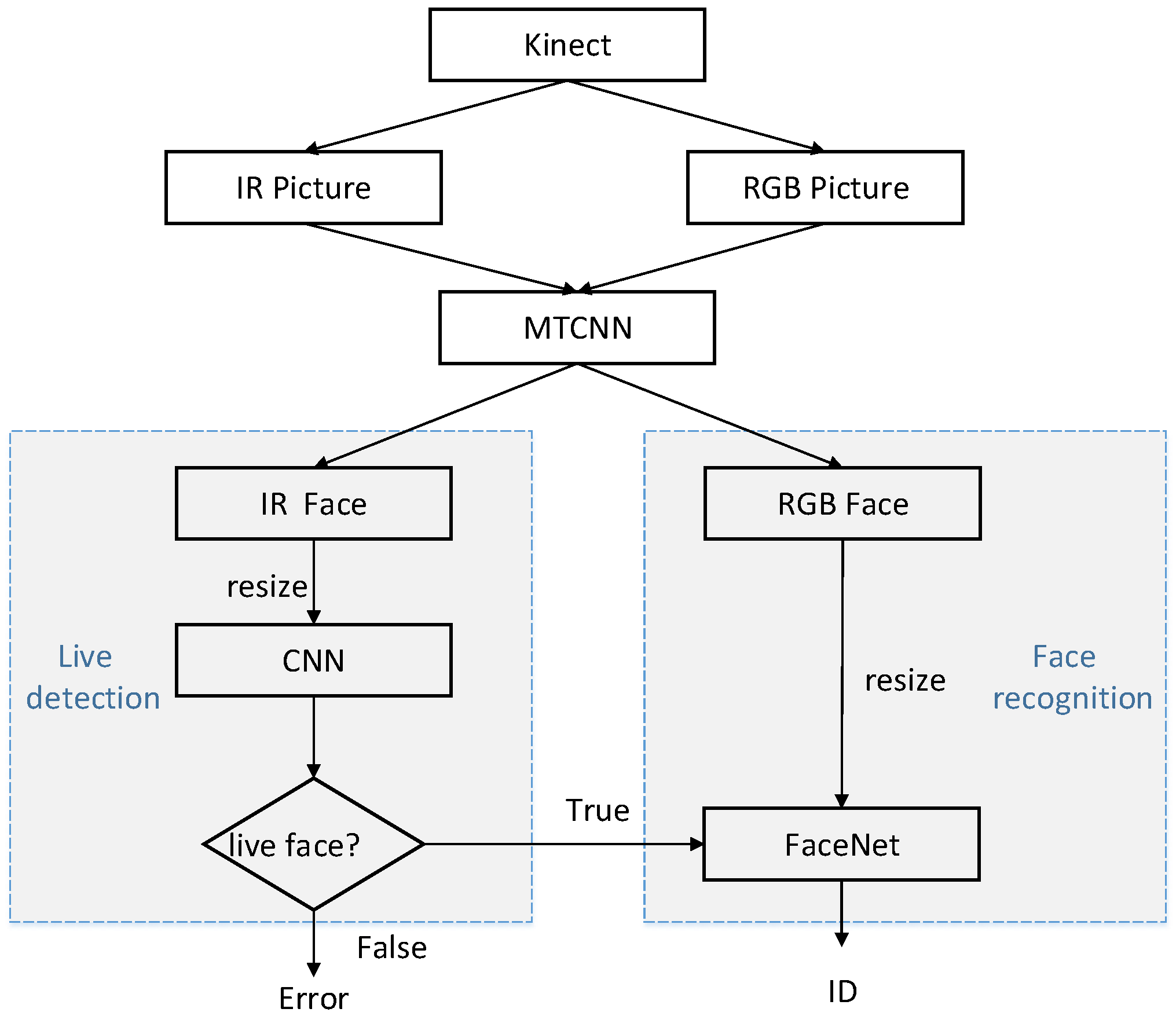




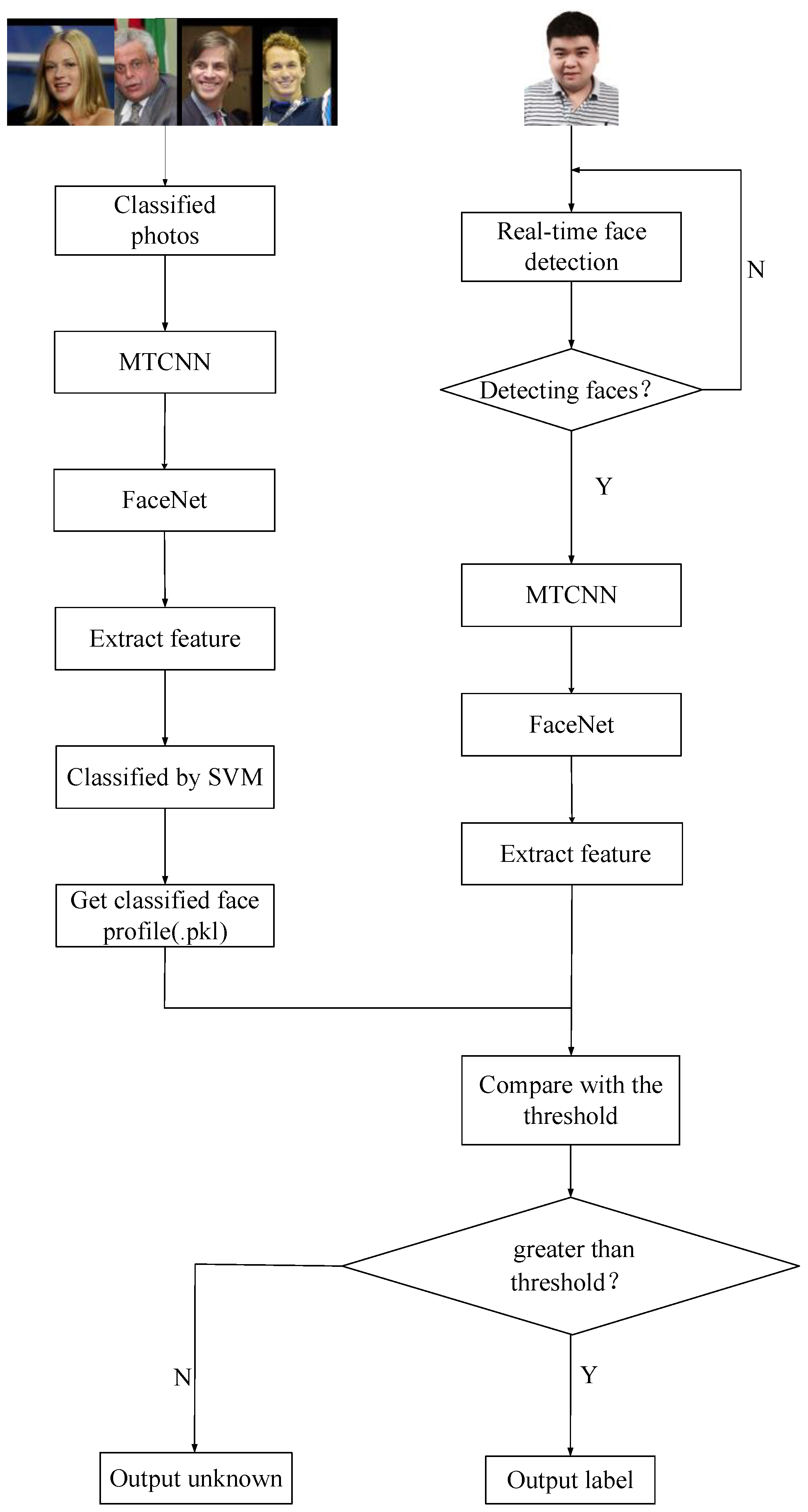
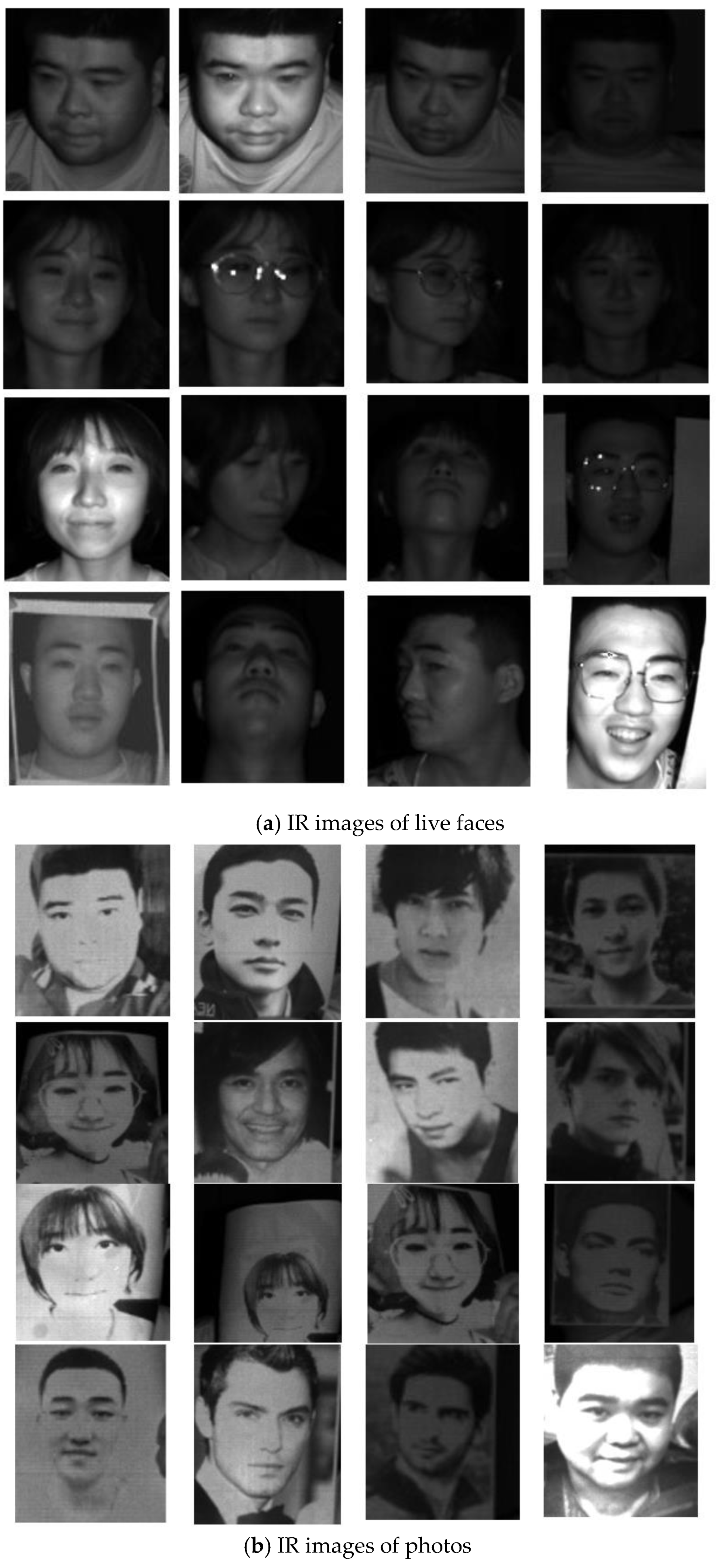


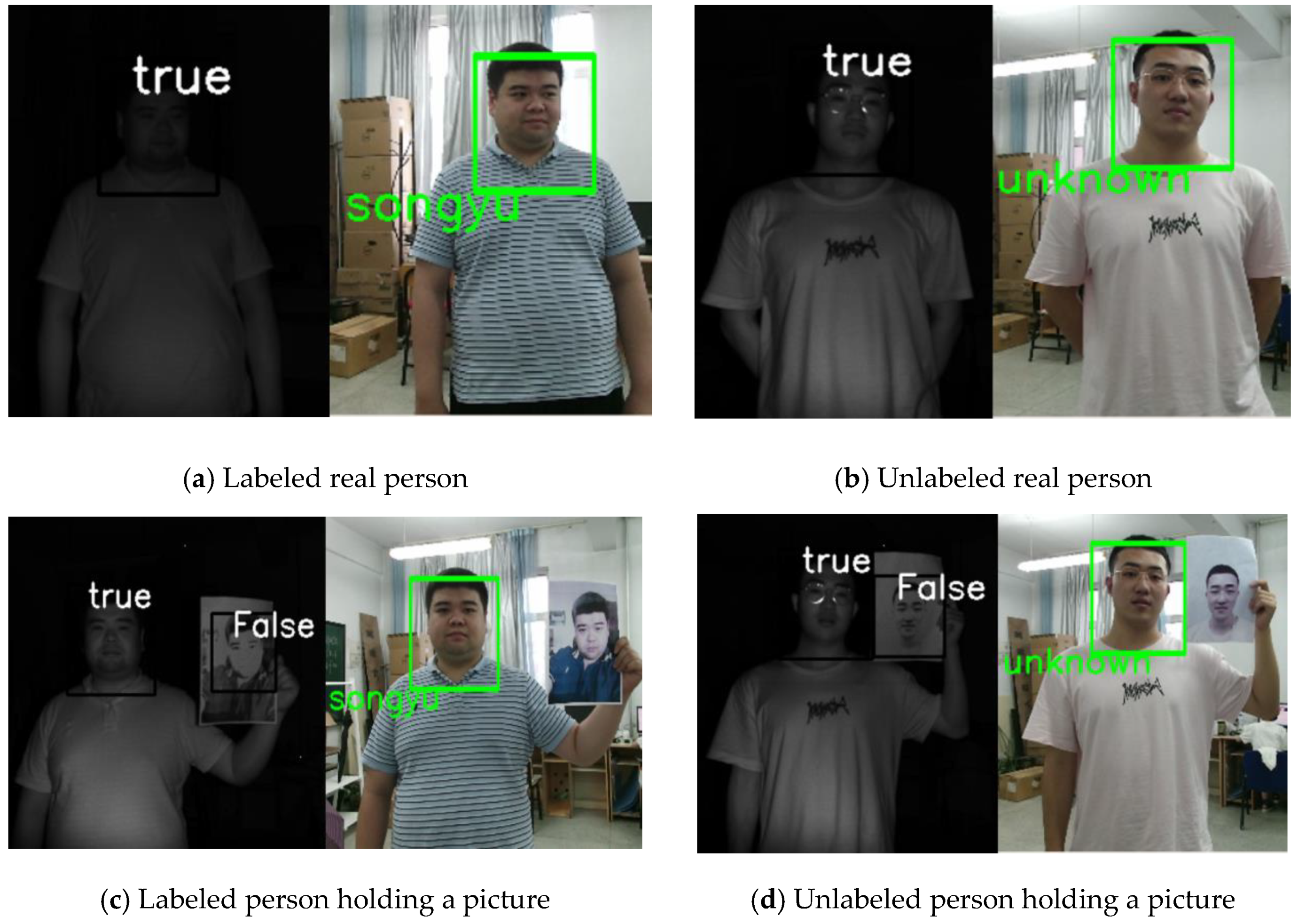
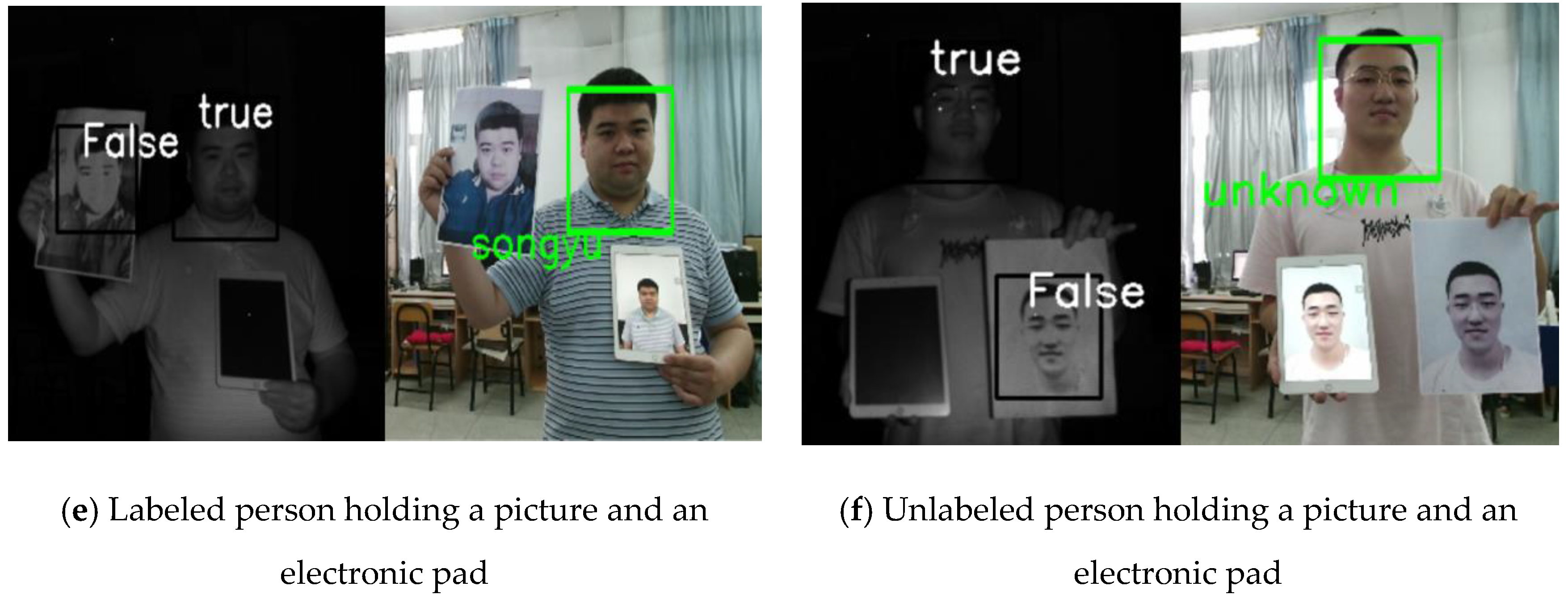
| Training Images | Validation Images | Test Images | |
|---|---|---|---|
| Real faces | 8400 | 1050 | 1050 |
| Spoof faces | 6030 | 753 | 753 |
| total | 14,430 | 1803 | 1803 |
| Replay-Attack ERR (%) | CASIA ERR (%) | NenuLD ERR (%) | |
|---|---|---|---|
| DOG(baseline) [26] | - | 17.0 | - |
| DLTP [27] | 7.13 | 7.02 | - |
| Deep Learning [15] | 6.1 | 7.3 | - |
| DPCNN [17] | 2.9 | 4.5 | - |
| LDIR | - | - | 0.2 |
| People in Dataset | Strangers | |
|---|---|---|
| FaceNet | Output correct results with 99.7% recognition rate | Output ID with Maximal similarity (error) |
| IFaceNet | Output correct results with 99.7% recognition rate | Output “unknown” (correct) |
| Accuracy of Live Detection | Accuracy of Face Recognition | Total Accuracy |
|---|---|---|
| 99.8% | 99.7% | 99.5% |
© 2019 by the authors. Licensee MDPI, Basel, Switzerland. This article is an open access article distributed under the terms and conditions of the Creative Commons Attribution (CC BY) license (http://creativecommons.org/licenses/by/4.0/).
Share and Cite
Liu, S.; Song, Y.; Zhang, M.; Zhao, J.; Yang, S.; Hou, K. An Identity Authentication Method Combining Liveness Detection and Face Recognition. Sensors 2019, 19, 4733. https://doi.org/10.3390/s19214733
Liu S, Song Y, Zhang M, Zhao J, Yang S, Hou K. An Identity Authentication Method Combining Liveness Detection and Face Recognition. Sensors. 2019; 19(21):4733. https://doi.org/10.3390/s19214733
Chicago/Turabian StyleLiu, Shuhua, Yu Song, Mengyu Zhang, Jianwei Zhao, Shihao Yang, and Kun Hou. 2019. "An Identity Authentication Method Combining Liveness Detection and Face Recognition" Sensors 19, no. 21: 4733. https://doi.org/10.3390/s19214733
APA StyleLiu, S., Song, Y., Zhang, M., Zhao, J., Yang, S., & Hou, K. (2019). An Identity Authentication Method Combining Liveness Detection and Face Recognition. Sensors, 19(21), 4733. https://doi.org/10.3390/s19214733





